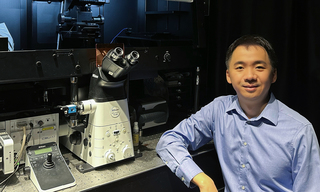Nikon BioImaging Labs provide contract research services for microscope-based imaging and analysis to the biotech, pharma, and larger research communities. Each lab's full-service capabilities include access to cutting-edge microscopy instrumentation and software, but also the services of expert biologists and microscopists, who are available to provide quality cell culture, sample preparation, data acquisition, and data analysis services.
We asked Dr. Peng Guo, Director of UCSD’s Nikon Imaging Center, a Core Lab for the University of California School System, what his impressions are of Lumencor’s products. We wanted to know how we might do more to satisfy the lighting needs of his lab and those of his customers. Here’s what he told us:
The UC San Diego facility is one of three Nikon Imaging Centers in the USA. There, we house the most cutting-edge microscopy platforms from Nikon and provide our lab as a resource to the users of UCSD, the San Diego community and beyond. We cover light microscopy, including wide-field, confocal, spinning disk, super-resolution techniques, as well as numerous specialized methods such as FRAP, FRET, multiplexing, etc. Our research needs are broad, ranging from basic research in subcellular biology to single-cell transcriptomics and epigenetics in neurological disorders. Our users’ samples include fixed and live cells, tissue sections, and organoids.
The proper illumination system is essential for high quality, quantitative microscopy. We need light sources to be stable, bright, predictable, and multicolored across a broad spectrum. The SPECTRA Light Engine from Lumencor, Inc. offers the multi-line illumination that our high-throughput microscope needs for stable illumination. It is well suited to match our filters. The acquired images are quantified by our home-developed pipelines.
If I could design my dream Light Engine, it would have as many discrete lasers as possible for multiplexing imaging from 360nm to 750nm. It would provide excitation that covers calcium imaging, standard confocal, and highly multiplexing imaging needs. It would solve problems that require multiple fluorophores to be imaged. We look to Lumencor for best-in-class illumination to support our very demanding and broad microscopy imaging needs.




